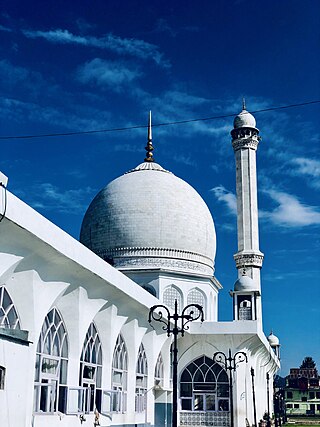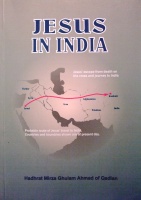
Srinagar is a city in Indian-administered Jammu and Kashmir in the disputed Kashmir region. It is the largest city and summer capital of Jammu and Kashmir, which is an Indian-administered union territory. It lies in the Kashmir Valley along the banks of the Jhelum River, and the shores of Dal Lake and Anchar Lakes, between the Hari Parbat and Shankaracharya hills. The city is known for its natural environment, various gardens, waterfronts and houseboats. It is also known for traditional Kashmiri handicrafts like the Kashmir shawl, papier-mâché, wood carving, carpet weaving, and jewel making, as well as for dried fruits. It is the second-largest metropolitan area in the Himalayas.

Ahmadiyya Islam considers Jesus (ʿĪsā) as a mortal man, entirely human, and a prophet of God born to the Virgin Mary (Maryam). Jesus is understood to have survived the crucifixion based on the account of the canonical Gospels, the Qurʾān, hadith literature, and revelations to Mirza Ghulam Ahmad. Having delivered his message to the Israelites in Judea, Jesus is understood to have emigrated eastward to escape persecution from Judea and to have further spread his message to the Lost Tribes of Israel. In Ahmadiyya Islam, Jesus is thought to have died a natural death in India. Jesus lived to old age and later died in Srinagar, Kashmir, and his tomb is presently located at the Roza Bal shrine.

The tomb of Jesus is the place where Jesus was entombed after his death. According to the gospel accounts, the tomb originally belonged to Joseph of Arimathea, a wealthy man who, believing Jesus was the Messiah, offered his own sepulcher for the burial of Jesus.

The Hazratbal Shrine, popularly called Dargah Sharif, is a Muslim shrine located in Hazratbal locality of Srinagar in Jammu and Kashmir, India. It contains a relic, Moi-e-Muqqadas, believed to be the hair of the Islamic prophet Muhammad. It is situated on the northern bank of the Dal Lake in Srinagar, and is considered to be Kashmir's holiest Muslim shrine.

The Roza Bal, Rouza Bal, or Rozabal is a shrine located in the Khanyar quarter in downtown area of Srinagar in Kashmir, India. The word roza means tomb, the word bal mean place. Locals believe a sage is buried here, Yuz Asaf, alongside another Muslim holy man, Mir Sayyid Naseeruddin.

Youza Asaf, Youza Asaph, Youza Asouph, Yuz Asaf, Yuzu Asaf, Yuzu Asif, or Yuzasaf, are Arabic and Urdu variations of the name Josaphat, and are primarily connected with Christianized and Islamized versions of the life of the Buddha found in the legend of Barlaam and Josaphat.

Fida Muhammad Hassnain was a Kashmiri writer, lecturer and Sufi mystic. He was born in 1924 in Srinagar, Kashmir, as the child of schoolteachers. His father fought with the British Indian forces in the Boer War in South Africa in 1902. Fida Hassnain graduated from the University of Punjab and the Aligarh Muslim University, and became a barrister, but the events surrounding the partition of colonial British India made him lose faith in the law, and after a short period of social work he became a lecturer in 1947 at the Sri Patrap (SP) College in Srinagar. In 1954, he became Director of the Kashmir State Archives, retiring in 1983. Fida Hassnain on died 9 July 2016 in Srinagar, Kashmir.

Jesus in India is a treatise written by Mirza Ghulam Ahmad, the founder of the Ahmadiyya Movement in 1889. The treatise, which was then published as a book, puts forward the view that Jesus survived crucifixion, left Judea and migrated eastward in order to continue his mission to the 'Lost Tribes of Israel', traveling through Persia and Afghanistan and eventually dying a natural and honourable death in Kashmir at an old age. The book also makes references to several lost Jewish tribes. Ghulam Ahmad applied textual analysis of both the Gospels and Islamic sources – the Quran and hadith – and also drew upon medical and historical material, including what he claimed were ancient Buddhist records, to argue his case. Some modern scholars such as Norbert Klatt (1988) have rejected Ghulam Ahmad's use of these latter sources as misreadings of material unrelated to Jesus.
Hardu-Aboora is a locality in Karhama tehsil in Baramulla district in the Indian union territory of Jammu and Kashmir. It is situated on the banks of Ferozpora Nallah, at the foothills of the mountain range that runs parallel to the Srinagar-Gulmarg highway on its left side, some 15 km (9.3 mi) from Tangmarg town, Baramulla and 29 km (18 mi) from the state capital, Srinagar, and 10 km (6.2 mi) from railway station Mazhama. Under new Administrative units, Hardu Aboora was granted CD Block status, under the jurisdiction of newly carved tehsil, Karhama.

Ziyarat Naqshband Sahab is a Sunni Muslim shrine, or ziyarat, in Srinagar in Jammu and Kashmir, India. It is one of the traditional Mausoleums of the Hazrat Ishaans, who are descendants of Bahauddin Naqshband and Mughal royals. Besides the Ziyarat Naqshband Sahab in Srinagar, Kashmir, the Hazrat Ishaans have a Ziyarat in Lahore in Begampura.

Dastgeer Sahib is a Sufi shrine located in the Khanyar locality of Srinagar, the summer capital of Jammu and Kashmir, India.
Khwaja Nazir Ahmad was an Ahmadiyya writer. After experiments with Hinduism and Christianity he converted back to Islam in 1919 and in 1923, aged 25, became imam of Woking's mosque. He returned to become a Senior Advocate of the Federal Court of Pakistan and an Advocate of His Majesty's High Court of Judicature at Lahore.
The Tarikh-i-Kashmir refers to several history books of Kashmir's Sultanate period, some of them lost and partially used as sources for the others.
Haji Mohi-ud-Din Miskin also Ghulam Mohiuddin was a Kashmiri poet who also wrote a history of Kashmir, Tarikh-i-Kabir. He is the first, after Mirza Ghulam Ahmad himself (1899), to record identification of the Roza Bal tomb with Jesus: "Others believe that it is [the] tomb of a great Prophet who is no other than Hazrat Isa [Jesus], the Spirit of God.” (1902).
Downtown, popularly known as Shahar-e-Khaas, is the largest and the most densely populated area of the city of Srinagar in the union territory of Jammu and Kashmir, India. The area is mostly located on the banks of Jhelum river about five km (3.1 mi) from city center. The area is considered as the core point in the city as the first inhabitants of the Srinagar lived there. In general, the whole area to the north of city centre Lal Chowk is considered a part of downtown although some areas hold high significance. The Jamia Masjid, Srinagar and many other shrines are located here, which makes it the central spiritual, religious, political and moral center of whole Kashmir.

Nallah Mar or Mar Canal was a navigational canal running through the old city of Srinagar in the Indian union territory of Jammu and Kashmir. It connected the Brari Nambal lagoon to the Khushal Sar lake and thus provided navigability between the Dal and Aanchar lakes. It was filled up and converted to a road in the 1970s.
On 27 December 1963, Moi-e-Muqqadas, a holy relic believed by many to be a strand from the beard of Muhammad, went missing the from the Hazratbal Shrine in Jammu and Kashmir, leading to widespread protests across the Indian subcontinent.

Jesus in Indien. Das Ende einer Legende is a 1985 book by the German indologist Günter Grönbold investigating the Islamic, Christian and Buddhist source material used by the Ahmaddiya Muslim founder Ghulam Ahmad in his book Jesus in India. The book is Grönbold's best known book among the general public in Germany, and is the most cited scholarly text about the sources of Ahmad's interpretation and the Roza Bal shrine among subsequent academic and popular writing. Following consideration of the original context and history of the literary sources cited by Ahmad and later Ahmaddiya supporters of the theory that Jesus of Nazareth survived the crucifixion and made a journey to India and was buried in Srinagar Kashmir, Grönbold concludes that Ahmad misidentified material about the putative Christian saint "Yuzafa" from the Barlaam and Josaphat traditions telling a Christianized version of the life of Siddhartha Gautama, as being material concerning Jesus of Nazareth. Grönbold's work was revisited, cited and developed by Norbert Klatt (1988) and Mark Bothe . Bothe regarded Grönbold as the first and only scholar in the area to have developed a history of the origination of the various "Jesus in India" legends.

In recent Ahmadi Muslim belief, the Mai Mari da Ashtan is the burial place of Mary, mother of Jesus, at one extremity of Muree in Pakistan.

Ladhoo or Ladhu is a village in the Pulwama district of Jammu and Kashmir, India. It is situated on the Jhelum River and of all villages in Pampore Constituency is one of the largest village. It is 18 km (11 mi) from Srinagar and 4 km (2.5 mi) from NH44 via Lethpora. It is spread over an area of 9 km2 (3.5 sq mi) including a long stretch of very famous trekking spot known as Wasturwan. This hill is also referred as 'Veshrivan' by some scholars and is said to be a store house of many myths and truths for the people living in its vicinity.












